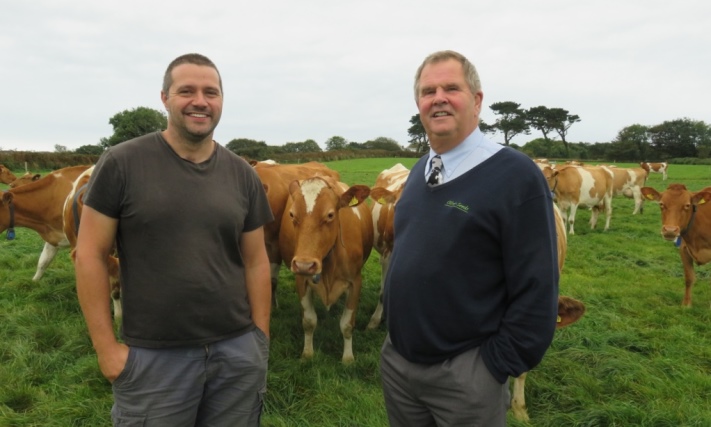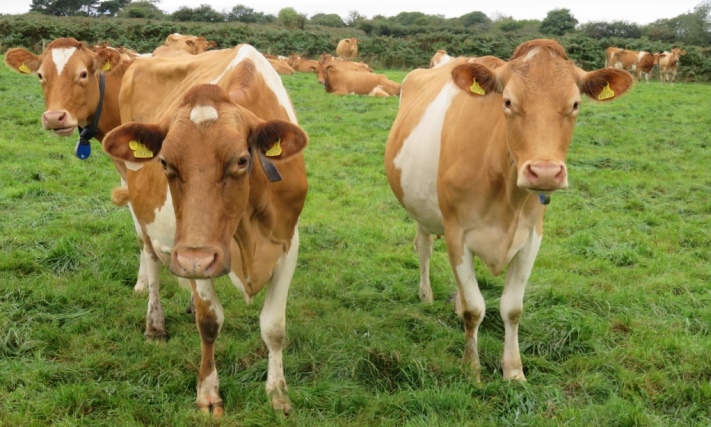Long-term future in grass
New dairy farmer hopes grass will secure his long-term future on Guernsey.
Michael Bray is one of just 14 dairy farmers left on the island of Guernsey, but is the only one adopting a New Zealand-style grazing system.
Growing up in a family involved in horticulture, Mr. Bray put an advert in the Guernsey Press saying he was looking for a dairy farm, having travelled and worked in New Zealand and the UK.

"Bon and Margaret Martel replied, as they were nearing retirement after 40 years. Their 80-cow pedigree Guernsey herd was once ranked the highest for yield in the UK. The farm had been in their family for generations but there was no obvious successor.
"After much discussion and two years to sort out the several tenancy agreements, my wife Susie and I took over Les Jaonnets Farm in 2012, buying all the cows and machinery. All the land is still rented through Bon and Margaret.”
Les Jaonnets runs to 100 vergees (vgs) (16ha) of land owned by the Martels, mostly close to the main buildings. This consists of 55 fields, the biggest just 10vgs (1.6ha). There are a further 440vgs (72ha) rented in small parcels across the island, used to grow grass and maize silage and graze young and dry stock.
Mr Bray has increased cow numbers to 130 and block calves tightly in two batches - 60% in the autumn and 40% in spring. Having cows dry in the summer matches slowing grass growth at that time. The one milk buyer, the Guernsey Dairy, based at St Andrew in the south east of the island, requires level supply through the year for milk, cheese, cream and ice cream.
System changes
The herd used to be set-stocked and housed for six months of the year in a high input/high output system, yielding 7,500 litres of milk with high milk solids averaging 5.47% fat and 3.51% protein.
As soon as Mr Bray took over, astroturf was laid down and permanent electric fencing and water troughs installed to allow rotational grazing. This offered cows fresh grazing every 12 hours in summer and 24 hours at the shoulders of the season with some silage buffer fed. The cows are now housed from late November to early March.
New grass
In the past four years, the whole farm has been reseeded into short and medium term leys to increase productivity.

Aided by grassland specialist Tony Walkers of Oliver Seeds, who visits the Channel Islands twice a year, to service customers there, Mr Bray has sown the mixtures Megabite with no added clover mainly for grazing, and Sabre Hi-Pro for silage.
A blend of intermediate and late perennial mainly diploid ryegrasses, Megabite also contains timothy, white clover and birdsfoot trefoil.
Formulated for full season production, the varieties included have high D values for high quality grazing and first year yield potential reaches 17.7t DM/ha. The mixture also has good ground cover, high grazing tolerance and can withstand drought conditions, which is important on Mr Bray's free-draining sandy loam soils. Youngstock outwinter on fields of established Megabite.
Sabre Hi-Pro is designed for silage leys, combining a blend of Italian and hybrid ryegrasses and Perseus festulolium with a red clover blend. Trials show a yield advantage of one tonne DM/ha in the second harvest year compared to a no clover version and the legume also boosts the protein content of the conserved forage.
To reseed, the fields are sub-soiled, rotavated and ploughed, before being power harrowed. The seed used to be drilled using a Fiona grass box that sat on top of the power harrow. However now a fanjet broadcaster is being used, as this gives much better seed distribution. The sowing rate is 15kg/acre and most of the reseeding is done in spring when the soil is still moist.
Docks and thistles are sprayed in established grassland with a translocated herbicide in spring.
Fertiliser is applied sparingly to the grazing fields at 340kg N/ha/year of 20.10.10 immediately after it has been grazed. Slurry is used as the primary source of nutrients for the Sabre Hi-Pro silage at 1800 gallons/vg/year along with 300kg N/ha/year of Nitram for the remaining Sabre silage ground. The time taken to cart and spread slurry to fields on the other side of the island adds additional cost to this operation. The closed season for slurry spreading runs from 1 October to the end of December.
All silage for the 14 dairy farms on Guernsey is cut and carted by one contracting company, so harvest date can be a compromise for some. Grass silage making starts from early May, with Mr Bray aiming for around 26 May due to early spring grazing. He aims to take two or three cuts a year.
Other crops
Early maize variety Emmerson is grown on 80vg (13ha) of off-lying land - the furthest five miles away by road from the main farm. Drilled in late May, the crop is harvested at the end of September and currently provides 40% of the winter cow ration. Mr Bray is considering whether he will keep growing maize in future, as it does not fit well with a low cost, grass-based philosophy. Making more grass and red clover silage could be an option.
In 2015, Mr Bray first drilled 28vg (4.6ha) with Winfred, a semi dwarf rape, a cross between stubble turnip and kale. Producing high protein leafy forage after six to eight weeks of sowing, it provides ideal forage for outwintered bulling heifers, fed with bales of late-cut stalky grass silage. The animals are strip grazed behind an electric fence and came through the winter in much better condition than when outwintered on just grass.
Results
Four years in, the system is almost complete - with the final fencing and installation of troughs just happening now. While cow numbers have increased by 50%, milk yields have dropped by 1,000 litres to 6,500 litres per cow with butterfat at 5.27% and protein at 3.63%. While the amount of 24% crude protein concentrate fed per cow, in out of parlour feeders and topped up in the parlour, has dropped to two tonnes/year, the total amount bought has stayed the same, as there are more cows to feed. But the aim is to drop this to around one tonne/cow/year.
The move from all year round calving to two tight blocks has improved fertility, with calving interval falling from 420 to 392 days, and this is expected to continue. Vet bills have been slashed from regular monthly visits to just two visits in the past year.
Mr Bray does not measure grass growth formally - relying on his eye. However now the farm is better set up, weekly measuring will be key to increasing fresh grass intakes. Rotation length in mid summer averaged 24 days this year, but he hopes to cut this to 21 days next season.
"We are currently sending 720,000 litres/year to the Guernsey Dairy and receive 49p/litre, including a 12.5p/litre State of Guernsey subsidy (at December 2016)," explains Mr Bray. "This might sound good to UK farmers - but remember all our inputs have to be brought in, which makes them much more expensive, with the cost to ship a pallet of goods starting at £60".
"We are here to stay and that is why I am investing in all the new infrastructure. By taking this drastic change in how we produce our milk, we hope to secure the farm's future. Since we came four years ago, the island has lost four more of its dairy farmers, and more are likely to go.
"The grass-based system is not for everyone, but I see it as the best way for us to produce a profitable, productive and long-term system here."
This is an edited version of an article that appeared in Farmers Guardian on 24 February 2017
